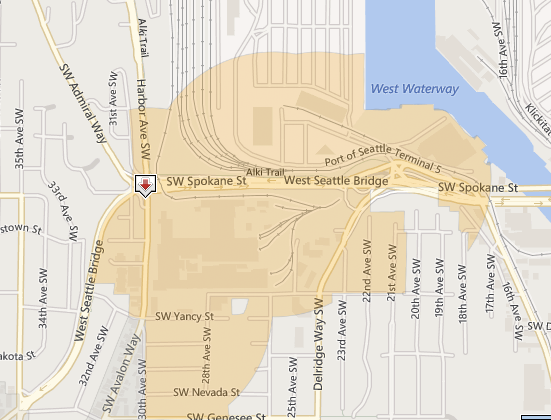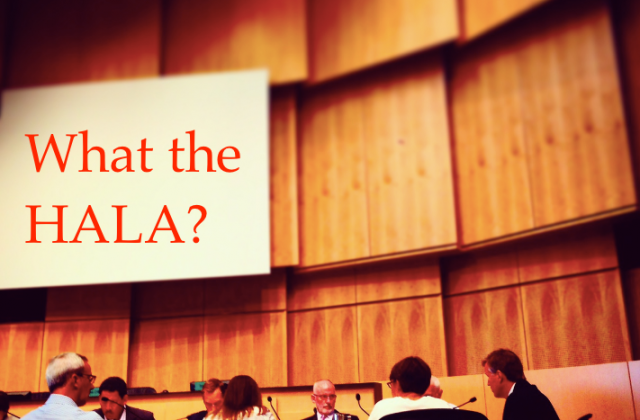Vanishing Journalism: More Hype on Parking in Seattle
At the Seattle Times there is yet another story that seems to have written itself: parking in Seattle is vanishing! Mike Lindbloom authored a front page story in Sunday’s Times that presents data about the reduction of free on street parking spots in favor or transit, parks, and bikes as if it was a body count, complete with a map showing how many spots have been “lost” around the city. And what effect is this having on life in the city?
The push to improve mobility and livability leaves less room for cars along the curb. The quick drive to the dry cleaner, the five-minute run to the minimart, having a friend pick you up outside your apartment — simple parts of a daily routine all have become harder, sometimes impossible.
Lindbloom’s story makes this great parking loss seem as if it was accidental product of new development and a “conspiracy” at the City to little, by little eliminate parking spots. Lindbloom says this is only “partly true.” In a way, it’s completely true since it’s part of a plan. Here’s the parking statement from Seattle’s Comprehensive Plan:
LUG4 Establish off-street parking requirements for new development to provide parking for the occupants of the structure. Set off-street parking requirements to reduce reliance on automobiles, promote economic development, and reduce housing costs.
LUG5 Regulate the location of off-street parking and the size and location of curbcuts to reduce parking and vehicle traffic impacts on pedestrians and residential and commercial streetscapes, and to prevent obstacles to commerce and traffic flow.
LUG6 Encourage the use of alternatives to single-occupant vehicles and the use of smaller, more energy efficient automobiles through the City’s regulation of parking, including the amount of parking required, design of parking, location of parking, and access to parking. [Emphasis mine]
There is it is, right there in the Comprehensive Plan. The purpose of not favoring parking on the right of way or requiring parking in new projects when transit is available is clearly stated City policy based on the best science and practice. Climate change is real but so are the impacts of impervious surfaces on drainage and lakes, streams, and the Puget Sound. And less parking means we can build more housing, and parking is an expense (there is no such things as free parking) usually absorbed by renters in the form of higher housing costs. When neighbors demand more “free parking” as they always do after a story like this, the only people that will pay are renters in the form of higher rents for off street parking spots. That’s why parking requirements have been relaxed and other options are eliminating on street parking.
What annoys many of us is the journalistic approach to these stories that blasts headlines about vanishing on street parking as if it was news. It isn’t. It’s established City policy. What is news is what I wrote about last week: the potential loss of many, many housing units all over the city because of a neighborhood appeal of one project in West Seattle. Somehow that isn’t dramatic enough. Lindbloom’s story even comes with the elderly lady who will be harmed by the loss of parking:
Lois Horn, 91, lost the three-minute load zone in front of her condo when the Roosevelt bike lane went in. She now walks four blocks to a hotel, wearing a clip-on red flasher in a crosswalk, when her family comes to pick her up.
“When I die, and my furniture needs to be moved out, they won’t have a place to park,” Horn said
I feel bad for Lois Horn, based on the limited information in Lindbloom’s story. And I park too, and I hate having to hunt for a spot when I am late or pay extra for off street parking when I can’t find a “free” option. But, as they say, “that’s life in the big city,” especially this city that has decided to favor other modes and affordable housing instead of publicly subsidized car storage for single-family neighbors. Trotting out a 91-year old woman’s suffering as if it was emblematic of the suffering caused by parking policies is, in my opinion, over the top and not accurate.
On Facebook and Twitter, I called Lindbloom’s story “lazy journalism.” Here’s what someone said (a person that has my respect) said in criticism of my assessment of Lindbloom’s story:
Roger, what the hell is ailing you? The story is 99.5% pretty straight reporting of a changing urban landscape, complete with statistics and quotes from a variety of points of view, only one of which is the changed situation of Lois Horn. Mike Lindblom is not a lazy journalist. He’s one of the best. Are you having a bad hair day?
and
I have been with it for 25+ years, and trying to support what you’ve been trying to do – serving on committees, councils, the legislature – arguing for more density, less regulation. Use whatever phrase you like directed at me … your post was a cheap shot. Mike Lindblom doesn’t get to choose either the cover shot or the headline, that’s another department
Well, I disagree. While Lindbloom does quote from people making the points I’ve made above he didn’t need the dramatic headline, the 91 year old woman, and the body count of parking spots to tell a story. He’s professionally responsible for the whole story because his name is on it, and this story cheapens the discourse by it’s maudlin tone about Lois Horn. My having to drive around the block 5 times and end up paying for parking is an inconvenience that is worth it because it is part of a sustainable strategy to sustainably grow our city and create more housing options for people of all levels of income. Instead of outrage, that story might channel the outrage into demands for more housing, more transit, and more alternatives to the car instead of angry e-mails to City Council demanding more parking.
Fox and Valdez Agree: Greatest Housing Need is Among the Poor
Proposed linkages taxes on every new square foot of new housing built in the city are premised on the idea that Seattle faces a “workforce housing” shortage; we don’t have enough housing for people who earn 60 percent of Area Median Income (AMI) and above. We’ve been saying that the need isn’t at that level of income, but lower levels, the truly poor. Many on the other side of the housing discussion (those who want to penalize developers for building housing) agree with us. The nexus for housing taxes for workforce housing simply doesn’t exist; we need to prioritize solutions like the levy to expand housing at lower levels of income and the Multifamily Tax Exemption (MFTE) program. We may not agree on the solutions, but even John Fox and I agree that the City is looking at the wrong place to find a problem.
————
February 7, 2015
Dear Mayor Murray,
We have come together to write this letter because although there are a great many things we disagree about, there is one thing that we both have found while researching housing need data: the greatest housing need in Seattle is not at higher levels of income, but at lower levels especially for those earning at or below 30 percent of Area Median Income (AMI).
With respect to the ongoing work of the current Housing Advisory Task Force, and direction of city housing policy in general, we are concerned that far too much emphasis is being placed on providing housing assistance to those with incomes between 60-80 percent of AMI. Many workers in Seattle don’t even earn that much, yet it’s been characterized as “work force housing.” Using 30 percent of monthly AMI to measure housing need doesn’t account for many people who pay less than that but are still struggling to make ends meet
Everyday in our city, truly poor people have to make difficult choices about where they will spend the night. Often that means sleeping in cars, outdoors, or staying in dangerous situations of abuse or domestic violence. Additionally, many people find themselves on the verge of homelessness whose incomes don’t keep pace with rising rents and other costs. These are people whose incomes fall below 30 or even 50 percent of the median. All the data is clear: this is where by far there is the greatest, most critical, and immediate need.
Every review of data also indicates there is a large surplus of housing at higher levels of income, especially at 60 to 80 percent AMI. To quote from the King County assessment of housing need:
Critical Need is for affordable rental housing for very-low and low-income households. While the amount of rental housing stock affordable to households earning above 60 percent of median income appears adequate
Yet, the City continues to pursue sending more resources to subsidize housing for people earning 60 percent AMI and above while also encouraging participation in the Multifamily Tax Exemption (MFTE) Program. Even when accounting for the “down renting,” people earning higher levels of income but renting units priced for those at lower income levels, there still is a good supply of housing for people earning at or above 60 percent of AMI.
Our organizations do not agree on exactly how to address need below 30 percent AMI, but we do agree that’s where the problem is. If we are going to collaboratively address our differences, find real solutions, please retain the emphasis where it is needed the most: serving those at the bottom of the income scale so they can continue to live in our properous city.
Sincerely,
John Fox Roger Valdez
Seattle Displacement Coalition Smart Growth Seattle
Parking Exemption in Transit Areas Under Threat
There is yet another challenge to housing supply and affordability in the city: the collapse of the City’s reduction of parking requirements in areas that have frequent transit. The letter below is in response to a serious impact on many, many housing projects in the city. Until now, builders of housing could use the City’s GIS map to calculate the average headways of transit to determine the frequency of transit. The Hearing Examiner decision throws doubt on every project in the city trying to reduce on site parking and thus the costs of construction, and, in the end housing price.
——————————–
February 10, 2015
Dear Mayor Murray and Councilmember O’Brien,
Last year the Hearing Examiner made a decision on a project in West Seattle (Parking Decision) that is having profound impacts on housing throughout the city. The decision affects all projects outside urban centers or station overlay areas proposing less parking for residents. These projects typically qualify for less (or, in urban villages, no) parking for most uses because they are served by “frequent transit.” Essentially, the frequent transit provision requires that the development must be within a quarter mile of a street with transit headways of not more than 15 minutes for 12 hours per day six days a week and not more than 30 minutes 18 hours per day seven days a week.
In 2012, DPD issued Director’s Rule 11-2012 (DR2012-11) that explained this frequent transit requirement. Among other things, this Director’s Rule explained that the frequent transit requirement is met if the average time between the buses (or other transit) complies with the headway requirement. This averaging is logical and reasonable in relation to Metro scheduling. A good example of this is the Rapid Ride D Line. At the Ballard stop this route has headways from 5:05 a.m. until after 9:00 p.m. of 15 minutes or less – with many headways of less than 10 minutes – except for one 17 minute headway around 4 p.m.[1]
The Examiner’s decision disallows averaging in determining frequent transit.
The decision reads, in part,
Had the Council intended that headways be averaged, it could have inserted the word “average” in two places within the definition to indicate that intent… [d]oing so would change the clearly stated meaning and the impact of the definition [of frequent transit].This can be accomplished only through legislation.
This elimination of averaging means that many projects which are clearly in areas that are very well served by transit do not qualify for this parking exception. This makes these projects, most of which are housing projects, infeasible.[2]
There are many factors which affect transit headway, including, I assume, anticipated traffic congestion during peak hours and transit-driver required breaks. Under the Hearing Examiner’s interpretation of the frequent transit requirement, one headway of 16 minutes during the requisite 12 hour period or one headway of 31 minutes during the requisite 18 hour period will disqualify that route from providing frequent transit service even if the average headway is less than 15 (or 30) minutes.
A minute here and there, in an 18 hour period, causes a project to fall outside the frequent transit requirement under the Hearing Examiner’s ruling. This is illogical and inconsistent with broader City policy to support less parking and more transit use, and will make many projects infeasible. In the end, this has the potential to reduce housing supply by hundreds of units and increase housing costs to provide unused parking.
We ask that the Council quickly pass legislation that clarifies the averaging issue as the Examiner suggest in order to preserve housing affordability in key neighborhoods in our city.
Sincerely,
Roger Valdez
[1]This is not an outlier. There are numerous other routes that have similar patterns.
[2] Additionally the Hearing Examiner disallowed the use of the GIS map for determining whether a project qualifies for a parking exemption for frequent transit, which should also be addressed in legislation.
What the HALA?: Council Considers More Bad Housing Legislation
As we pointed out last week, it appears that the Council is not taking the work of the Mayor’ s Housing Affordability and Livability (HALA) Committee seriously. Not only is the Council pushing to pass damaging low-rise legislation but now they’re pushing to short circuit affordability created through the City’s Multifamily Tax Exemption (MFTE) Program. Below is the text of letter addressed to the Mayor but also sent out to HALA Committee members, the City Council, and other City staff. It’s time for the Mayor to get ahold of this process before more damage is done to housing affordability.
————————-
February 7, 2015
Dear Mayor Murray,
I am writing you to point out yet another example of the City Council moving ahead with significant housing legislation that will adversely impact housing affordability in the city. Currently the Council’s Housing Committee is considering changes to the requirements for Small Efficiency Dwelling Units (SEDUs) and the Multifamily Tax Exemption (MFTE) Program.
Councilmember Clark is proposing a change MFTE that would require that units hold their rents to no more than 30 percent of the monthly income of a person earning 40 percent of Area Median Income (AMI)
This new requirement would reduce participation in MFTE and thus create fewer affordable units for people who earn 60 to 80 percent of Area Median Income (AMI). Ostensibly, the changes Councilmember Clark proposes are to create more participation at lower levels of income (40 percent AMI), but what this would do is not create units affordable to those lower levels, but result in no MFTE units at all.
The Office of Housing will tell you that based on their calculations the program won’t suffer any adverse impacts. But they have not taken into account higher rents that result from larger unit sizes and other requirements imposed by Councilmember O’Brien’s SEDU legislation last year.
Let’s look at an example; a 48-unit SEDU project with a 20 percent set aside and an annual expected City property tax of about $49,000.
In this example, because of the higher rents caused by last year’s legislation, participation is about a break even. What does it look like with a 40 percent requirement?
 At the 65 percent requirement the lost rent revenue is offset by the tax exemption. When the 40 percent requirement is imposed participation in the MFTE for SEDUs comes at an annual loss of more than $44,000.
At the 65 percent requirement the lost rent revenue is offset by the tax exemption. When the 40 percent requirement is imposed participation in the MFTE for SEDUs comes at an annual loss of more than $44,000.
Because of the higher rents created by the requirements from last year’s legislation, lowering the AMI requirements will mean SEDU projects just won’t participate in the MFTE program.
While the efforts of Councilmember Clark are motivated by a desire to create more affordability for lower levels of income, the result will be a drop in participation in MFTE and fewer overall affordable units.
We urge you and your Housing Affordability and Livability Agenda (HALA) Committee to intervene in the Council’s process and ask for this to be considered as part of the over all HALA process. If HALA can’t at least participate in the discussion of the impacts of this change, it further undermines their charge and the whole point of the Committee’s work, to “strengthen the Multifamily Tax Exemption (MFTE) program to more effectively spur development and retention of mixed-income rentals” (See attached HALA document, especially Section 1, Financing).
Sincerely,
Roger Valdez
Vaccinating Against High Prices: Build More Housing!
Last Monday, one week ago, I traveled to San Francisco to be part of a panel hosted by the San Francisco Bay Area Renters Federation, or SF BARF. Now you can watch the panel in the video embed above. As I mentioned earlier, SF BARF is led by the charismatic and relentless Sonja Trauss. Trauss is emerging as the Bay Areas leader in demanding more housing supply to offset rising housing prices, something that should be obvious by now but isn’t there or here in Seattle. The premise of the event reminds me of Herman Biggs comments about public health made at the turn of the 20th century, “public health is purchasable. Within natural limitations, a community can determine its own death rate.”
The cause of our current housing shortage isn’t technological – we know how to build. It’s not financial – investors are clamouring to invest in the Bay Area. It’s not the result of a raw material shortage – unlike the 1940-45 housing crisis when the war effort diverted labor and materials from private efforts, today we have all the laborers and materials we need.
The cause of our current shortage is 100% political.
As in many aspects of health and disease, we can control our own destiny vaccinating ourselves against measles because it works to protect children. Similarly, handing out more building permits to build more housing will make prices go down. In both cases, folk science can prevail with devastating results. Hopefully Seattle and San Francisco can keep working together and learning from each other to get the politics right and make both cities easier and more affordable to live in.







